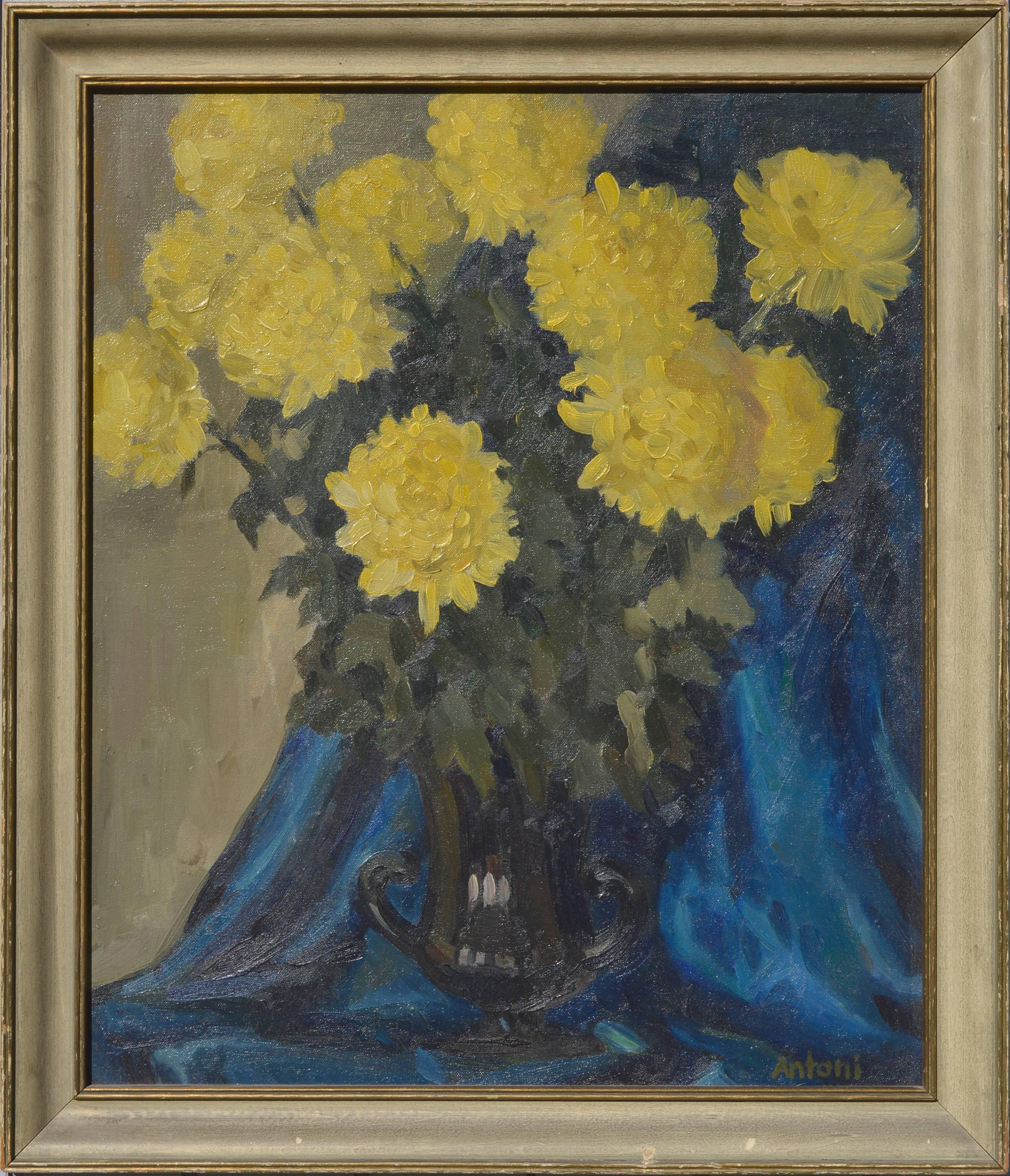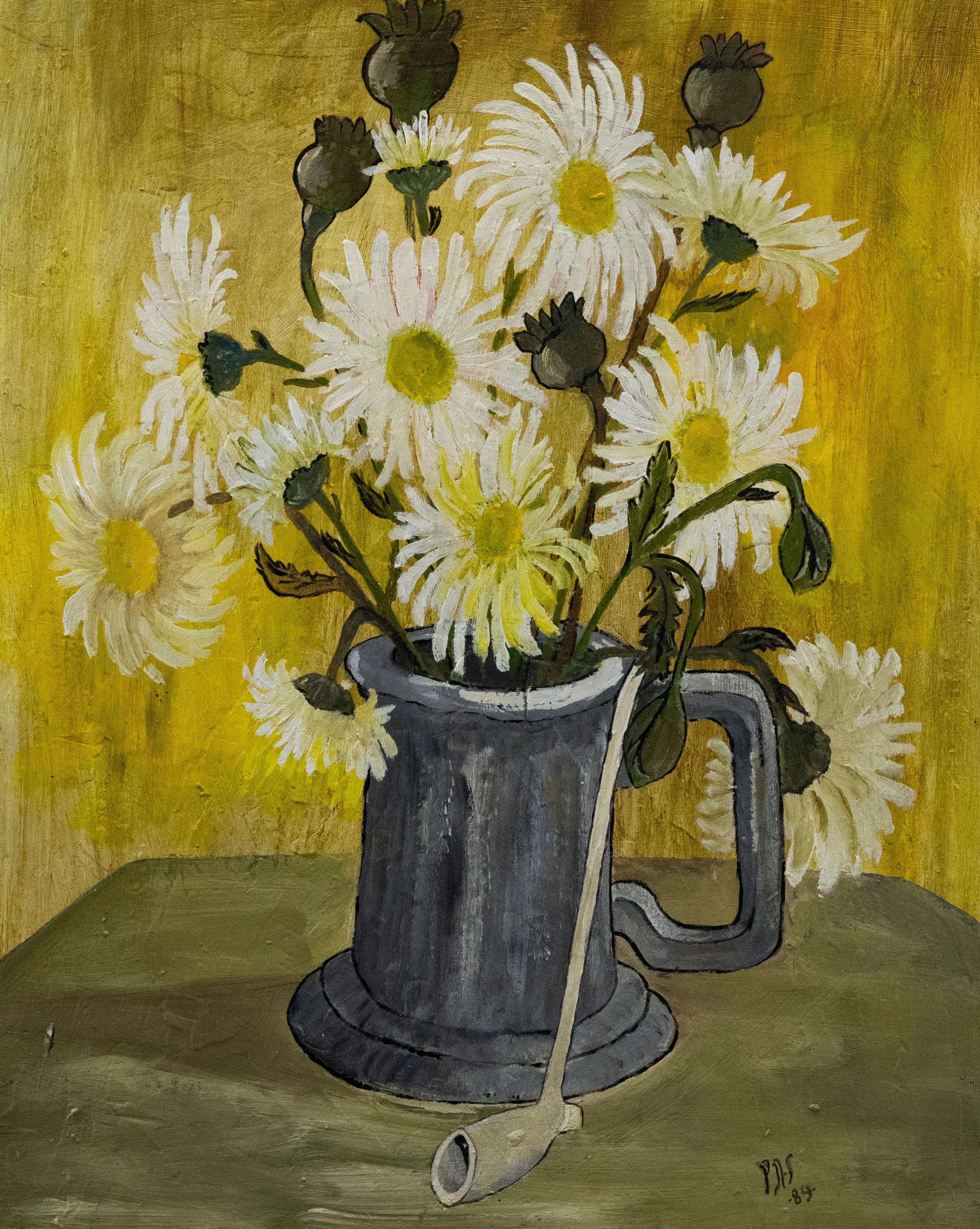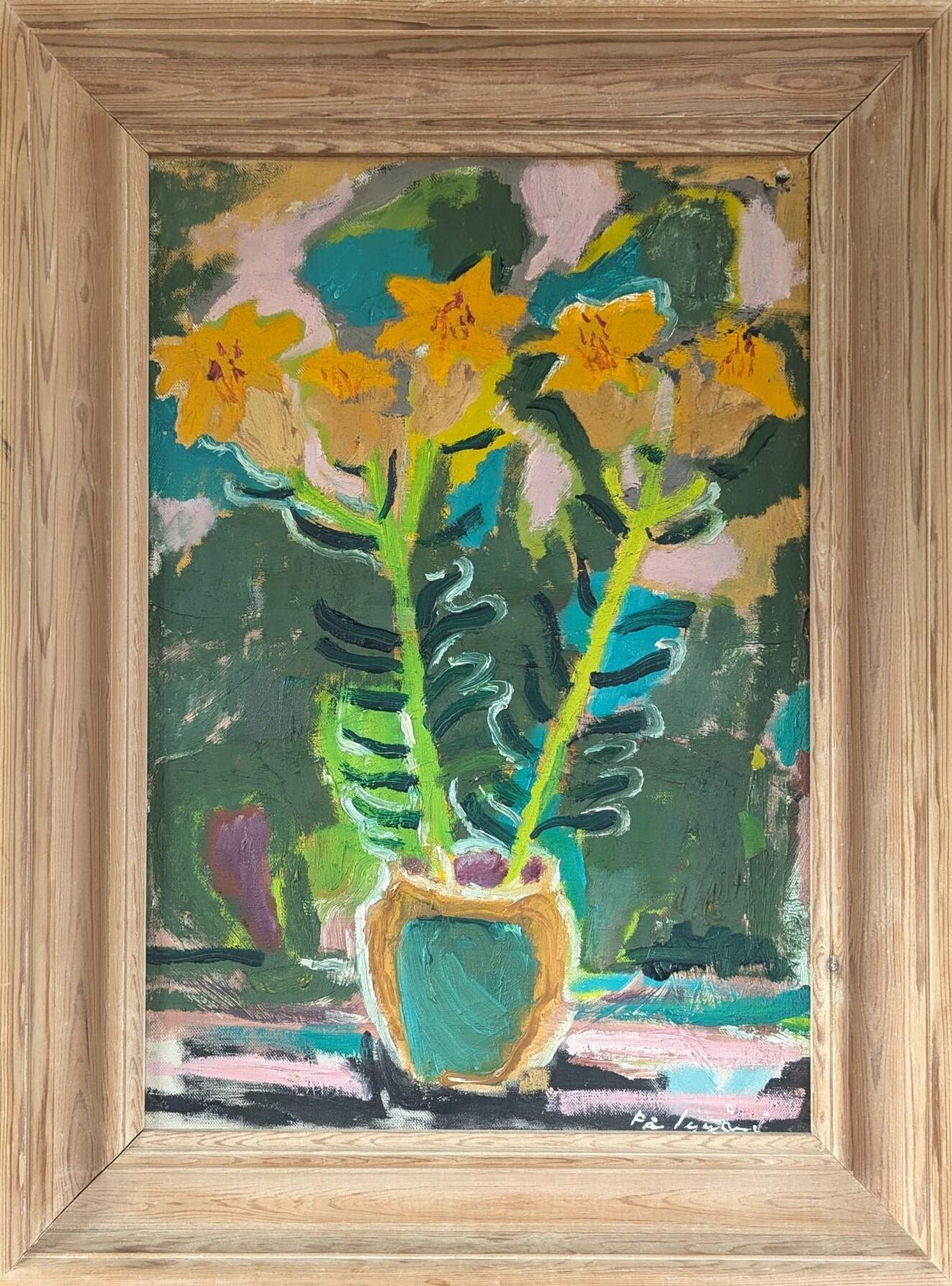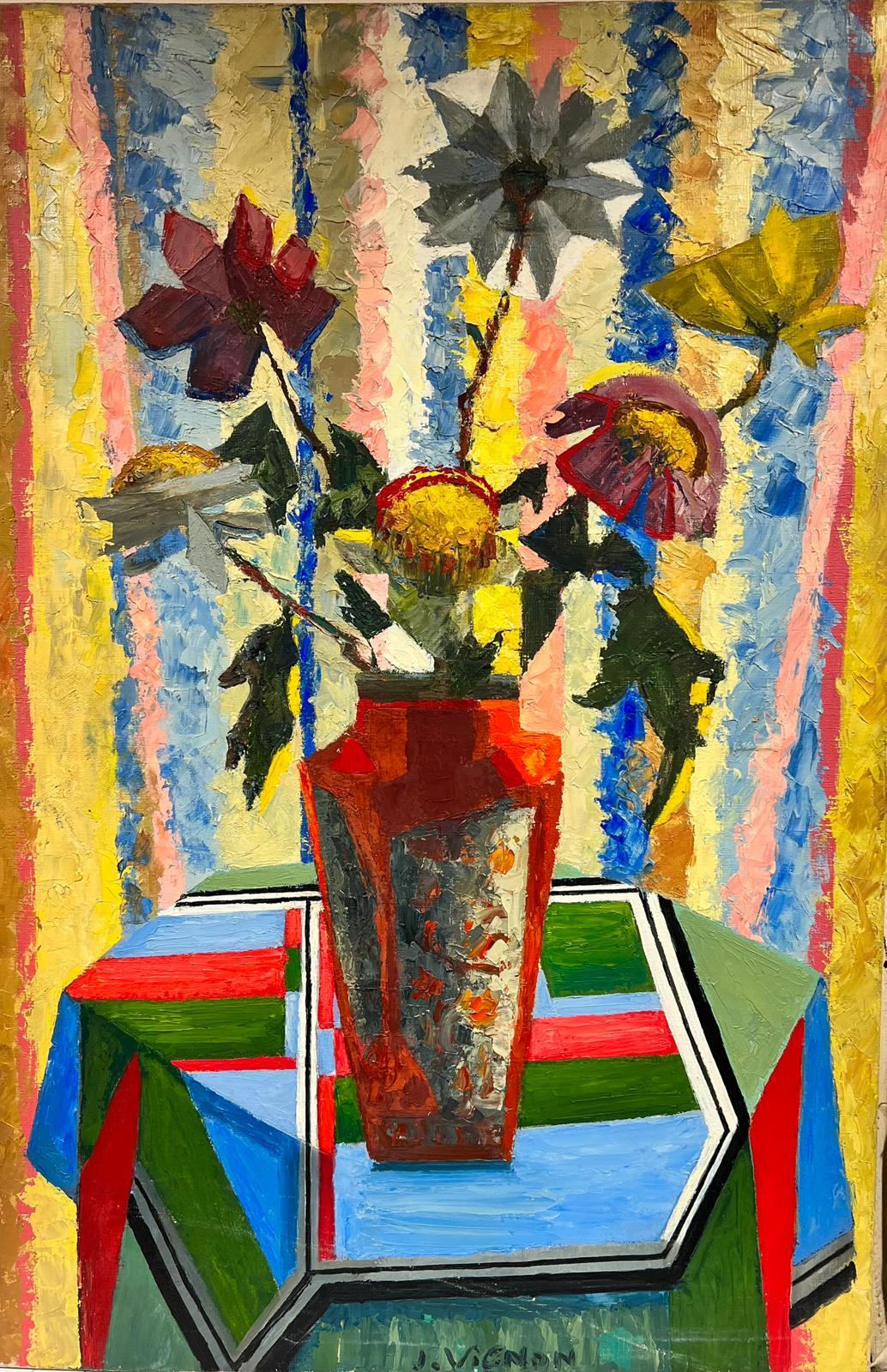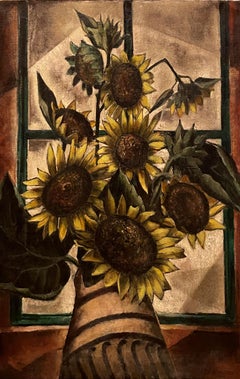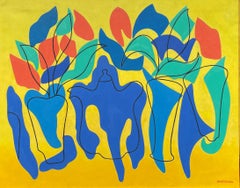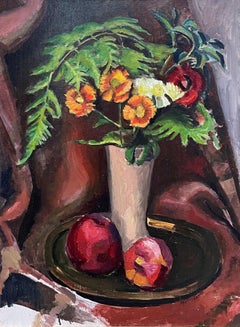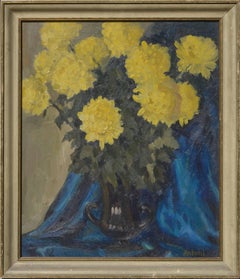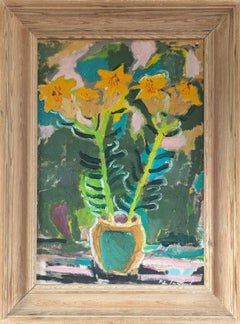Items Similar to "Mums" William S. Schwartz, Yellow Flowers, Cubist, Modern Still Life
Want more images or videos?
Request additional images or videos from the seller
1 of 10
William S. Schwartz"Mums" William S. Schwartz, Yellow Flowers, Cubist, Modern Still Lifecirca 1950
circa 1950
$5,200
$8,00035% Off
£3,942.31
£6,065.1035% Off
€4,544.45
€6,991.4635% Off
CA$7,323.37
CA$11,266.7235% Off
A$8,121.07
A$12,493.9635% Off
CHF 4,267.02
CHF 6,564.6535% Off
MX$99,225.68
MX$152,654.9035% Off
NOK 53,386.25
NOK 82,132.6835% Off
SEK 50,112.11
SEK 77,095.5635% Off
DKK 33,925.18
DKK 52,192.5835% Off
About the Item
William S. Schwartz
Still Life with Yellow Mums, circa 1950
Signed lower right
Oil on canvas
20 x 16 inches
Provenance:
Private Collection, Massachusetts
William Schwartz was born in Smorgon, Russia, in 1896, one of nine children in a poor family. He studied art at an early age, earning a scholarship at the Vilna Art School in Russia, 1908–12. He immigrated to the United States at age 17 in 1913, living in New York with his sister for eight months and then moving to Omaha, Nebraska, to live with his brother in 1915. Working as a house painter, he turned his attention to art, studying briefly with J. Laurie Wallace at the Kellom School in Omaha before moving to Chicago. He entered the School of the Art Institute of Chicago (SAIC) in 1916, studying with Ivan Trutnev and Karl A. Buehr, and graduating with honors in life drawing, portraiture, and painting in 1917. He supported himself as a tenor singer in vaudeville, concerts, and opera and received favorable reviews, but he chose to pursue painting instead of singing. His circle of artist friends included important Chicago modernists Aaron Bohrod, Malvin and Ivan Albright, Archibald Motley Jr., and Anthony Angarola. Angarola and Schwartz shared a studio for several years. Schwartz was given a solo exhibition at the Art Institute in 1926—a major accomplishment for 30-year-old artist—his first of three solo exhibitions there. It launched his successful career.
Schwartz established his own style of modernism, influenced by European modernists and American painter Arthur B. Davies. In the catalogue for a second solo show at the Art Institute in 1929, critic J. Z. Jacobsen praised Schwarz’s “powerful and rhythmic lithographs,” and observed that, “Schwartz is also a singer of note, and with this in mind one can more fully appreciate the weird harmonies and swaying movement of his creations in the realm of visual art.” With his use of bold design and flat color influenced by Gauguin and the stark, Fauve colors of Matisse, Schwartz’s works often challenged audiences. Although contemporary writers made efforts to define him as a romanticist rather than an American scene painter, his blend of naturalism and cubism—as seen in Village Number One and Gas Factory, Chicago, for examples—and especially his choice of everyday subject matter suggest an affinity with American scene school. He combined personal allegories and histories with an appreciation of industry and technology.
During the Depression, Schwartz was supported by the Federal Art Project. In 1933, he painted a mural titled Mining for the Century of Progress Exposition; in 1935, he produced a mural entitled Chicago for the Cook County Nurses’ Home, and one called American Musicians for the Glencoe Public Library. He was awarded WPA commissions, and completed murals for Illinois post offices in Fairfield, Eldorado, and Pittsfield. His Mural Study, 1935, for the post office in Pittsfield, shows his approach to constructing a scene that is both decorative and descriptive. Its bold colors and dramatic sky balance the grand span of the bridge and wide river below with a riverboat gliding below it. Family Picnic echoes this river view, situating a motley group of picnickers in the foreground. Schwartz used high-keyed colors and cubist-derived angular shapes to fill in the broad, curved hills on the horizon.
- Creator:William S. Schwartz (1896-1977, American, Russian)
- Creation Year:circa 1950
- Dimensions:Height: 29 in (73.66 cm)Width: 22 in (55.88 cm)
- Medium:
- Movement & Style:
- Period:
- Condition:
- Gallery Location:New York, NY
- Reference Number:1stDibs: LU1841213907982
About the Seller
5.0
Platinum Seller
Premium sellers with a 4.7+ rating and 24-hour response times
Established in 2022
1stDibs seller since 2022
120 sales on 1stDibs
Typical response time: <1 hour
- ShippingRetrieving quote...Shipping from: New York, NY
- Return Policy
Authenticity Guarantee
In the unlikely event there’s an issue with an item’s authenticity, contact us within 1 year for a full refund. DetailsMoney-Back Guarantee
If your item is not as described, is damaged in transit, or does not arrive, contact us within 7 days for a full refund. Details24-Hour Cancellation
You have a 24-hour grace period in which to reconsider your purchase, with no questions asked.Vetted Professional Sellers
Our world-class sellers must adhere to strict standards for service and quality, maintaining the integrity of our listings.Price-Match Guarantee
If you find that a seller listed the same item for a lower price elsewhere, we’ll match it.Trusted Global Delivery
Our best-in-class carrier network provides specialized shipping options worldwide, including custom delivery.More From This Seller
View All"Sunflowers, " Frank London, Modernist Yellow Floral Still Life with Window
Located in New York, NY
Frank Marsdon London (1876 - 1945)
Sunflowers
Oil on canvas
31 x 22 inches
Signed lower right
Exhibited:
Pittsburgh, Carnegie Museum of Art.
Frank Marsden London was born in the small Southern town of Pittsboro in central North Carolina in 1876. When he reached adulthood, London attended the University of North Carolina...
Category
1920s American Modern Still-life Paintings
Materials
Canvas, Oil
"Untitled" Albert Heckman, Still Life, Floral Abstracted Modernist Composition
By Albert Heckman
Located in New York, NY
Albert Heckman
Untitled, circa 1950
Signed lower right
Oil on canvas
25 1/4 x 32 1/4 inches
Albert Heckman was born in Meadville, Western Pennsylvania, 1893. He went to New York City to try his hand at the art world in 1915 after graduating from high school and landing a job at the Meadville Post Office. In 1917, at the age of 24, Heckman enrolled part-time in Teachers' College, Columbia University's Fine Arts Department to begin his formal art education. He worked as a freelance ceramic and textile designer and occasionally as a lecturer at the Metropolitan Museum of Art. In the early 1920s, at the age of almost 30, he graduated with a Bachelor of Arts degree from Columbia Teachers College. He was especially impacted by his instructor at Columbia, Arthur Wesley Dow.
After graduating, he was hired by the Teachers' College as a Fine Arts instructor. He stayed with Columbia Teachers' College until 1929, when he left to attend the Leipzig Institute of Graphic Arts in Leipzig, Germany. Isami Doi (1903-1965), who was born in Hawaii, was arguably his most impressive student at Columbia. Doi is now regarded as one of the most prominent artists hailing from Hawaii. Heckman became an active member and officer of the Keramic Society and Design Guild of New York in the 1920s as part of his early commercial art career. The Society's mission was to share knowledge and showcase textile and ceramic design exhibits.
In 1922, Heckman married Florence Hardman, a concert violinist. Mrs. Heckman's concert schedule during the 1920s kept Albert and Florence Heckman apart for a significant portion of the time, but they spent what little time they had together designing and building their Woodstock, New York, summer house and grounds. A small house and an acre of surrounding land on Overlook Mountain, just behind the village of Woodstock, were purchased by Albert and Florence Heckman at the time of their marriage. Their Woodstock home, with its connections, friendships, and memories, became a central part of their lives over the years, even though they had an apartment in New York City.
Heckman's main artistic focus shifted to the house on Overlook Mountain and the nearby towns and villages, Kingston, Eddyville, and Glasco. After returning from the Leipzig Institute of Graphic Arts in 1930, Mr. Heckman joined Hunter College as an assistant professor of art. He worked there for almost thirty years, retiring in 1956. Throughout his tenure at Hunter, Mr. Heckman and his spouse spent the summers at their Woodstock residence and the winters in New York City. They were regular and well-known guests at the opera and art galleries in New York. Following his retirement in 1956, the Heckmans settled in Woodstock permanently, with occasional trips to Florida or Europe during the fall and winter. Mr. Heckman's close friends and artistic career were always connected to Woodstock or New York City. He joined the Woodstock art group early on and was greatly influenced by artists like Paul and Caroline Rohland, Emil Ganso, Yasuo Kuniyoshi, Andre Ruellan, and her husband, Jack Taylor.
Heckman operated a summer art school in Woodstock for several years in the 1930s with support from Columbia University, where these and other Woodstock artists gave guest lectures. The Potter's Shop in New York City hosted Mr. Heckman's first art show in December 1928. The exhibit received some positive reviews from critics. The American Institute of Graphic Arts chose the plate of "Wehlen, Saxony" as one of the "Fifty Prints of the Year in 1929." There were sixteen etchings displayed. The remaining plates depicted scenes in Saxony, Germany, while five of the plates were based on scenes in Rondout, New York.
Heckman started switching from etching to black and white lithography by the early 1930s. A lifelong admirer of Heckman's artwork, Mr. Gustave von Groschwitz organized a significant exhibition of Heckman etchings and lithographs at the Ferargil Gallery in New York City in 1933. The exhibition traveled to the Stendahl Galleries in Los Angeles (May 1933), the Charles Lessler Gallery in Philadelphia (May 1933), J.L. Hudson in Detroit (June 1933), and Gumps in San Francisco (July 1933). Together with his early etchings, the exhibition featured brand-new black and white lithographs depicting scenes in and around Woodstock as well as "A View from Tudor City...
Category
1950s Abstract Figurative Paintings
Materials
Canvas, Oil
"Untitled" Albert Heckman, Modernist Saturated Blue and Yellow Still Life
By Albert Heckman
Located in New York, NY
Albert Heckman
Untitled, circa 1950
Signed lower right
Oil on canvas
18 x 24 inches
Albert Heckman was born in Meadville, Western Pennsylvania, 1893. He went to New York City to try his hand at the art world in 1915 after graduating from high school and landing a job at the Meadville Post Office. In 1917, at the age of 24, Heckman enrolled part-time in Teachers' College, Columbia University's Fine Arts Department to begin his formal art education. He worked as a freelance ceramic and textile designer and occasionally as a lecturer at the Metropolitan Museum of Art. In the early 1920s, at the age of almost 30, he graduated with a Bachelor of Arts degree from Columbia Teachers College. He was especially impacted by his instructor at Columbia, Arthur Wesley Dow.
After graduating, he was hired by the Teachers' College as a Fine Arts instructor. He stayed with Columbia Teachers' College until 1929, when he left to attend the Leipzig Institute of Graphic Arts in Leipzig, Germany. Isami Doi (1903-1965), who was born in Hawaii, was arguably his most impressive student at Columbia. Doi is now regarded as one of the most prominent artists hailing from Hawaii. Heckman became an active member and officer of the Keramic Society and Design Guild of New York in the 1920s as part of his early commercial art career. The Society's mission was to share knowledge and showcase textile and ceramic design exhibits.
In 1922, Heckman married Florence Hardman, a concert violinist. Mrs. Heckman's concert schedule during the 1920s kept Albert and Florence Heckman apart for a significant portion of the time, but they spent what little time they had together designing and building their Woodstock, New York, summer house and grounds. A small house and an acre of surrounding land on Overlook Mountain, just behind the village of Woodstock, were purchased by Albert and Florence Heckman at the time of their marriage. Their Woodstock home, with its connections, friendships, and memories, became a central part of their lives over the years, even though they had an apartment in New York City.
Heckman's main artistic focus shifted to the house on Overlook Mountain and the nearby towns and villages, Kingston, Eddyville, and Glasco. After returning from the Leipzig Institute of Graphic Arts in 1930, Mr. Heckman joined Hunter College as an assistant professor of art. He worked there for almost thirty years, retiring in 1956. Throughout his tenure at Hunter, Mr. Heckman and his spouse spent the summers at their Woodstock residence and the winters in New York City. They were regular and well-known guests at the opera and art galleries in New York. Following his retirement in 1956, the Heckmans settled in Woodstock permanently, with occasional trips to Florida or Europe during the fall and winter. Mr. Heckman's close friends and artistic career were always connected to Woodstock or New York City. He joined the Woodstock art group early on and was greatly influenced by artists like Paul and Caroline Rohland, Emil Ganso, Yasuo Kuniyoshi, Andre Ruellan, and her husband, Jack...
Category
1950s Modern Interior Paintings
Materials
Oil, Canvas
"Floral Still Life with Two Apples" Hayley Lever, Modernist Still Life Painting
By Hayley Lever
Located in New York, NY
Hayley Lever
Floral Still Life with Two Apples
Signed lower right
Oil on canvas
20 x 16 inches
Hayley Lever’s versatility has worked against his posthumous reputation. He was never...
Category
Early 20th Century Modern Still-life Paintings
Materials
Canvas, Oil
"Cardinal Flowers Still Life, June" Walter Gay, Red and White Floral Bouquet
By Walter Gay
Located in New York, NY
Walter Gay (1856 - 1937)
Cardinal Flowers Still Life, June, 1875
Signed lower left; dated on the reverse
Oil on board
24 3/4 x 7 1/8 inches
Provenance:
Private Collection, Brunswick, Maine
Born in Hingham, Massachusetts, Walter Gay became a painter who specialized in interiors, particularly those of eighteenth-century French buildings. His style was traditional, and he ignored the influences of modernist paintings he saw while studying in Paris beginning 1876. He remained in Europe the rest of his life.
In his compositions, the rooms are nearly always devoid of human presence but suggest that someone has been there. Many of his interiors are museum settings, and although he was not an impressionist, his work often had atmospheric effects.
When Gay died in 1937, he was described in The New York Times as the "Dean of American Painters in France," where he and his Matilda moved in 1876. His first paintings there were genre subjects and realistic views of peasant life in Britanny, but he tired of these works, which he called "pot boilers."
In the 1890s, he began his signature interiors, mostly rooms in fashionable houses of the Gays and their friends. Reproductions of many of these paintings were published in 1920 by Albert Gallatin, also a painter. The Gays, with a retinue of about twenty servants, loved old houses, and lived in an eighteenth-century apartment on the Left Bank in Paris from January through April and beginning 1904, in a chateau in the countryside at le Breau, near Fontainebleau. There they had 300 acres of grounds to roam.
In 1907, they purchased this chateau which became quite a showplace and where they entertained extensively. However, during World War II, when Matilda was living there as a widow, German soldiers occupied the chateau, ruining much of the structure and plotting the destruction of the country the Gays loved...
Category
1870s American Impressionist Still-life Paintings
Materials
Oil, Board
"Still Life of Fruit " Albert Swinden, American Abstract Association, AAA
By Albert Swinden
Located in New York, NY
Albert Swinden (1901 - 1961)
Still Life of Fruit, 1937
Oil on canvas
18 x 30 inches
Provenance:
Graham Gallery, New York
Albert Swinden (1901–1961) was an English-born American abstract painter. He was one of the founders of the American Abstract Artists, and he created significant murals as part of the Federal Art Project.
Albert Swinden was born in Birmingham, England in 1901. When he was seven, he moved with his family to Canada, and in 1919 he immigrated to the United States. He lived in Chicago, where he studied for about a year and a half at the Art Institute. He then relocated to New York City, where his art education continued briefly at the National Academy of Design. He soon changed schools again, to the Art Students League, which he attended from 1930 to 1934. He studied with Hans Hofmann and gained an appreciation for Synthetic Cubism and Neoplasticism. According to painter and printmaker George McNeil, Swinden "could have influenced Hofmann ... He was working with very, very simple planes, not in this sort of Cubistic manner. Swinden was working synthetically at this time." While still a student, Swinden began teaching at the Art Students League, in 1932.
Swinden married Rebecca Palter (1912–1998), from New York. Their daughter, Alice Swinden Carter, also became an artist. Carter, who attended the School of the Museum of Fine Arts, Boston, received an award from the Institute of Contemporary Art, Boston for her large sculptures.
Swinden was hired for the Federal Art Project (FAP) of the Works Progress Administration (WPA), and he is best known for the murals which he painted as part of that project.
In 1935, New York City Mayor Fiorello La Guardia attended the opening of the inaugural exhibit at the Federal Art Project Gallery, accompanied by Audrey McMahon, New York regional director for the Works Progress Administration/Federal Art Project. Among the works on display was Abstraction, a sketch by Swinden; it was the design for a mural planned for the College of the City of New York. A newspaper account described it as consisting of "brightly colored T-squares, triangles and rulers in horizontal, vertical and diagonal positions". La Guardia asked what it was, and upon being told it was a mural design, he said he didn't know what it depicted. Someone joked that it could be a map of Manhattan. The displeased mayor stated that "if that's art, I belong to Tammany Hall." (Tammany Hall, which the Republican mayor referenced, was the New York Democratic Party political society.) Fearing that the mayor's negative attitude could jeopardize the future of abstract art within the Federal Art Project, McMahon dispatched an assistant to summon an artist who could speak to the mayor in defense of abstraction. The assistant returned with Arshile Gorky.
Swinden played an important role in the founding of the American Abstract Artists. In 1935, he met with three friends, Rosalind Bengelsdorf, her future husband Byron Browne, and Ibram Lassaw, with the goal of exhibiting together. The group grew and started meeting in Swinden's studio, which adjoined those of Balcomb and Gertrude Greene...
Category
1930s Modern Still-life Paintings
Materials
Canvas, Oil
$4,800 Sale Price
20% Off
You May Also Like
Yellow Mums with Blue Drape - Midcentury Floral Still Life
By Antoni
Located in Soquel, CA
Yellow chrysanthemums in a black vase with a deep blue backdrop come together in a beautiful midcentury still life oil painting by Central Valley and Los Angeles, California artist A...
Category
1970s American Impressionist Still-life Paintings
Materials
Masonite, Oil
$1,080 Sale Price
20% Off
Floral Still Life - British art 1930 Post Cubist oil painting red yellow flowers
By Paul Earee
Located in Hagley, England
This appealing original oil on canvas painting is by British artist Paul Earee. Painted in a Post Cubist manner circa 1930, this floral still life depicts a vase of flowers on a table in bold blocks of colour. A really vibrant painting in superb tones.
Signed lower right.
Provenance. Estate of the artist.
Condition. Oil on canvas. Image size 24 inches by 20 inches and in excellent condition.
Housed in a gallery frame with complementary tones, 31 inches by 27 inches approx framed.
As Frederick Percy Eary, he was born at Sudbury, Suffolk on 16 July 1888, son of Albert Henry Eary (1862-1941), mat weaver, and his wife Hannah (1860-1939). Known as Paul Earee, he was an artist who was professionally trained as an ecclesiastical architect, art teacher and illustrator, using his spare time in painting, etchings and drawing with strong regional content. As an architect he designed many buildings and interiors in Sudbury including the pulpit of St Gregory...
Category
1930s Cubist Still-life Paintings
Materials
Oil
P. H. S. - 1989 Oil, Chrysanthemums on Yellow
Located in Corsham, GB
A charming still life study of a vase of chrysanthemums with a pipe. The artist capture the scene in an expressive style. Signed and dated to the lower right. On board.
Category
20th Century Still-life Paintings
Materials
Oil
$254 Sale Price
20% Off
Mid Century Modern Swedish Expressive Still Life Oil Painting - Yellow Flowers
Located in Bristol, GB
YELLOW FLOWERS
Size: 60.5 x 45 cm (including frame)
Oil on board
A mid century modernist floral composition, painted in oil onto board.
This painting depicts a vibrant and expressi...
Category
Mid-20th Century Modern Still-life Paintings
Materials
Oil, Board
Mid Century French Cubist Signed Oil Painting Still Life of Flowers in Vase
By Josine Vignon
Located in Cirencester, Gloucestershire
Cubist Still Life of Flowers
circa 1960
by Josine Vignon (French 1922-2022)
signed
oil painting on canvas, unframed
canvas: 32 x 21 inches
very good condition
provenance: from the a...
Category
Mid-20th Century Post-Impressionist Abstract Paintings
Materials
Canvas, Oil
Flowers with a Yellow Background
By Humbert Howard
Located in Milford, NH
A fine impressionist floral still life by American artist Humbert Howard (1905-1990). Howard was born in Philadelphia and considered an important figure among contemporary African-American artists. He was educated at Howard University in Washington, D.C., the University of Pennsylvania in Philadelphia, and the Barnes Foundation in Merion, Pennsylvania. Howard was also art director of the Pyramid Club, a respected black cultural center in Philadelphia. As director of the club’s art exhibitions, he selected works by both black and white artists for display.
By the time he retired in 1971, he had developed a loyal following of collectors and dealers in the Philadelphia area. In the eighties, he became increasingly involved with younger members of the local art scene and became a mentor to emerging black artists...
Category
1980s American Impressionist Still-life Paintings
Materials
Oil, Panel
More Ways To Browse
Russian Cubist Art
Aaron Stills
Vintage Nurse
Vintage Mining Signs
Nurse Vintage Art
Mid Century Picnic
Jacobsen Oil Painting
Archibald Motley
Riverboat Painting
Still Life Painting Strawberries
Victorian Oil Painting Of Flowers
Fruit Bowl Oil On Canvas
Wine And Fruit Paintings
Matisse Vase
Raspberry Painting
Still Life Painting Antique Fruit
Seascape 18th
Teacup Painting
